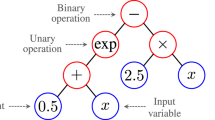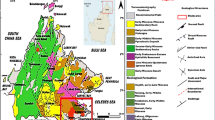Abstract
In many earth sciences applications, the geological objects or structures to be reproduced are curvilinear, e.g., sand channels in a clastic reservoir. Their modeling requires multiple-point statistics involving jointly three or more points at a time, much beyond the traditional two-point variogram statistics. Actual data from the field being modeled, particularly if it is subsurface, are rarely enough to allow inference of such multiple-point statistics. The approach proposed in this paper consists of borrowing the required multiple-point statistics from training images depicting the expected patterns of geological heterogeneities. Several training images can be used, reflecting different scales of variability and styles of heterogeneities. The multiple-point statistics inferred from these training image(s) are exported to the geostatistical numerical model where they are anchored to the actual data, both hard and soft, in a sequential simulation mode. The algorithm and code developed are tested for the simulation of a fluvial hydrocarbon reservoir with meandering channels. The methodology proposed appears to be simple (multiple-point statistics are scanned directly from training images), general (any type of random geometry can be considered), and fast enough to handle large 3D simulation grids.
Similar content being viewed by others
REFERENCES
Bridge, J. S., and Leeder, M. R., 1979, A simulation model of alluvial stratigraphy: Sedimentology, v. 26, p. 617–644.
Caers, J., and Journel, A. G., 1998, Geostatistical quantification of geological information for a fluvialtype North-Sea reservoir: SPE paper no. 56655.
Caers, J., Srinivasan, S., and Journel, A. G., 1999, Stochastic reservoir simulation using neural networks trained on outcrop data: SPE paper no. 49026.
Deutsch, C. V., 1992, Annealing techniques applied to reservoir modeling and the integration of geological and engineering (well test) data: Unpublished doctoral dissertation, Stanford University, 306 p.
Deutsch, C. V., and Journel, A. G., 1998, GSLIB: Geostatistical software library and user's guide, 2nd ed.: Oxford University Press, New York, 368 p.
Deutsch, C. V., and Wang, L., 1996, Hierarchical object-based stochastic modeling of fluvial reservoirs: Math. Geol., v. 28, no. 7, p. 857–880.
Farmer, C. L., 1988, The generation of stochastic fields of reservoir parameters with specified geostatistical distributions, in Edwards, S., and King, P. R., eds., Mathematics in oil production: Clarendon Press, Oxford, p. 235–252.
Gómez-Hernández, J. J., 1991, A stochastic approach to the simulation of block conductivity fields conditioned upon data measured at a smaller scale: Unpublished doctoral dissertation, Stanford University, 351 p.
Goovaerts, P., 1997, Geostatistics for natural resources evaluation: Oxford University Press, New York, 483 p.
Guardiano, F., and Srivastava, R. M., 1993, Multivariate geostatistics: Beyond bivariate moments, in Soares, A., ed., Geostatistics-Troia, Vol. 1: Kluwer Academic, Dordrecht, p. 133–144.
Haldorsen, H. H., and Damsleth, E., 1990, Stochastic modeling: J. Pet. Technol., v. 42, April, p. 404–412.
Journel, A. G., 1993, Geostatistics: Roadblocks and challenges, in Soares, A., ed., Geostatistics-Troia, Vol. 1: Kluwer Academic, Dordrecht, p. 213–224.
Journel, A. G., 1997, Deterministic geostatistics: A new visit, in Baffi, E., and Shofield, N., eds., Geostatistics Wollongong, Vol. 1: Kluwer Academic, Dordrecht, p. 174–187.
Journel, A. G., and Alabert, F. G., 1989, Non-Gaussian data expansion in the Earth Sciences: Terra Nova, v. 1, p. 123–134.
Omre, H., 1991, Stochastic models for reservoir characterization, in Kleppe, J., and Skjaeveland, S. M., eds., Recent advances in improved oil recovery methods for North Sea sandstone reservoirs: Norwegian Petroleum Directorate, Stavanger, 14 p.
Roberts, E. S., 1998, Programming abstractions in C: A second course in computer science: Addison-Wesley, Reading, MA, 819 p.
Srivastava, M., 1992, Iterative methods for spatial simulation: Stanford Center for Reservoir Forecasting, Rep. No. 5, 24 p.
Srivastava, M., 1995, An overviewof stochastic methods for reservoir characterization, in Yarus, J., and Chambers, R., eds., Stochastic modeling and geostatistics: Principles, methods, and case studies, Vol. 3: AAPG Computer Applications in Geology, Tulsa, p. 3–16.
Strebelle, S., 2000, Sequential simulation drawing structures from training images: Unpublished doctoral dissertation, Stanford University, 200 p.
Tjelmeland, H., 1996, Stochastic models in reservoir characterization and Markov random fields for compact objects: Unpublished doctoral dissertation, Norwegian University of Science and Technology.
Tran, T. T., 1994, Improving variogram reproduction on dense simulation grids: Comput. Geosci., v. 20, no. 7, p. 1161–1168.
Xu, W., 1996, Conditional curvilinear stochastic simulation using pixel-based algorithms: Math. Geol., v. 28, no. 7, p. 937–949.
Author information
Authors and Affiliations
Rights and permissions
About this article
Cite this article
Strebelle, S. Conditional Simulation of Complex Geological Structures Using Multiple-Point Statistics. Mathematical Geology 34, 1–21 (2002). https://doi.org/10.1023/A:1014009426274
Issue Date:
DOI: https://doi.org/10.1023/A:1014009426274




